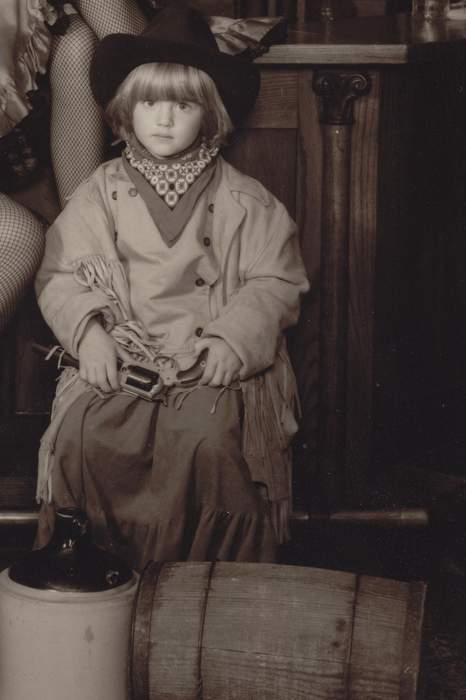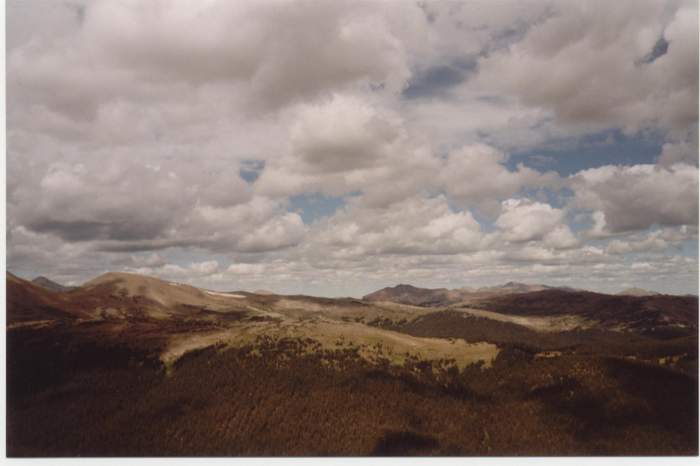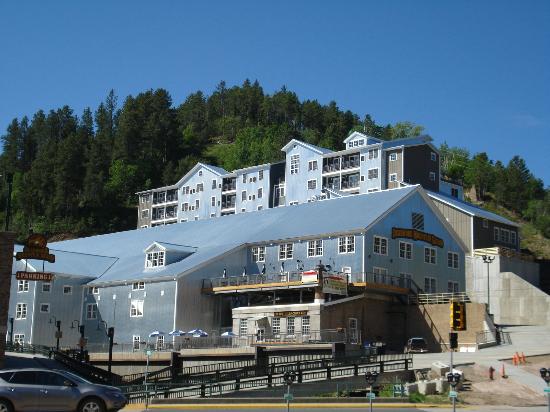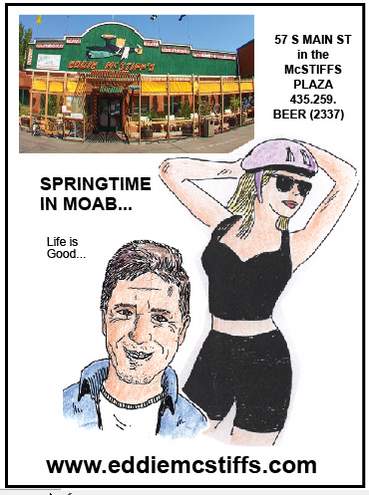I know the drive back home intimately. Coming from any direction, the Black Hills are a forested island, rising out of the dust-sea of plains. The hills are old and carry all the legends of old age. Harney Peak, where the Seven Sisters rose into the stars to form the Pleiades constellation, lies in the South; Wind Cave, home to the Buffalo Lady, a few miles down the road. Just outside Sturgis, my hometown, Bear Butte stands as testimony to centuries of spirit quests, to the boyhoods of men like Crazy Horse and Sitting Bull, and also to the continuing saga of greed. When climbing the Butte, it’s always disheartening to know General Custer stood in the same spot in 1874, surveying the land South and West, and he imagined himself master of everything he saw.
To those moving into the area, the Black Hills are an oasis, a “fairy-land” as journalists described them in Custer’s time. It’s true that the hills are beautiful, thick with Ponderosa Pine and Black Hills Spruce, whitetail deer, mountain lions and coyotes. The snowmelt each spring lets loose waterfalls and rushing streams down through the hills. And, in the fall, the leaves of the few deciduous trees, fluttering brilliant red and yellow off their branches, blanket the forest floor. With winter comes the snow. It falls in a fury, thick, erasing roads, vehicles, even entire homes, and then, after hours, or even days, departs suddenly and quietly. In the wake of such snowfall, the earth lies still. The hills are hushed. Those who can still open their front doors do. They look out into the white, breathless.
I was never surprised that people wanted to live in the Hills. People are drawn to mythological places, and the Black Hills, as I knew them, were choked in their own mythology. I was raised five miles from Deadwood, witness to the death of Wild Bill Hickok and the mourning of Calamity Jane. Both are buried above the town in Mount Moriah Cemetary, where they can peacefully watch over the telling and re-telling of their memories. Gunshots from the re-enactments of Wild Bill’s death, and trial of his killer, Jack McCall, echo through the Deadwood streets on summer afternoons. Among the clatter of fake bullets, saloon girls pile on makeup and flouncy satin costumes to charm the tourists and lead them into casinos, where out-of-towners and seniors bussed in from the local retirement homes sit reverent, with identical frowns, at the rows of machines.
Some people were making good money from the flashy saloons and casinos lining Deadwood’s Main Street, but I didn’t know any of them. The owners were typically from somewhere else. “California,” locals would practically spit, seeing a New Ownership sign on the front of a casino, or a new mansion rise along Interstate 90. Wherever all that money went, not enough of it was trickling down to the people I knew—the people who cleaned the tables, mixed the drinks, vacuumed the motel floors.
General Custer’s dream, and the industry which gave birth to Deadwood, was gold—though no one’s seen much of it in South Dakota for quite a while. When I was growing up, the Homestake Gold Mine in Lead, South Dakota hadn’t enjoyed a boom year since 1877; and, though it didn’t fully close operations until 2002, business lagged all through the nineties. Fathers of friends lost their jobs, families moved away, more houses lay empty. Stray cats roamed the worn down residential districts. Rumors circulated through the hills of chemicals leaching into Lead’s water supply. Too many people had cancer. Too many women couldn’t have children. By the early years of the new millennium, Lead could have been a ghost town.
After I left town, the derelict Deadwood Slime Plant, a key piece of the town’s historical gold industry, was transformed into the “Deadwood Mountain Grand” Resort. Pictured Below.
In Sturgis, where my sister and I attended school, most businesses were only open two weeks a year. While Deadwood had slot machines, we had Harley Davidson—and bars. Lots of bars. For two weeks a year, Sturgis was either hell or heaven, depending whom you asked. Most locals fled town while two to five hundred thousand people descended, decked out in leather, motorcycles humming, purring, screaming through the streets. The smart locals rented out their basements, extra rooms, even made campsites of their front yards, charging visitors $1000 or more a week for a couple square feet of grass. Most every young girl in the area worked the Rally at least once. We vied for two-week positions at the local bars, campgrounds, street vendors, bike washes. If you looked good in a bikini, you were pretty well assured a gig. Guys worked the Rally too, but since they weren’t working the “sexy” jobs, they didn’t make the same kind of money.
 The rest of the world, witness only to those two weeks, painted my home town, Sturgis, as a biker metropolis—but the other fifty weeks of the year, Sturgis was a ranching town. Quiet, empty, and very poor. Most of the men in town worked construction. Most women were waitresses or, if they were lucky, secretaries. Teenagers loitered in front of the grocery store after school. Ranchers gathered mornings at Bob’s Restaurant to talk shop. As a child, I often begged my parents to take me into Bob’s, and sometimes, despite their concern for their cardiovascular health, they did. As the child of two professionals, both of whom worked in nearby, relatively sophisticated Rapid City, I understood nothing about cattle prices or feed costs—but I loved the rhythm of the ranchers’ talking, the words they used. These were words understood by my classmates, many of whom were ranchers’ kids, whom I envied for having horses and cowboy boots. As a child, I would have traded all my toys, (and probably my older sister,) for a horse.
The rest of the world, witness only to those two weeks, painted my home town, Sturgis, as a biker metropolis—but the other fifty weeks of the year, Sturgis was a ranching town. Quiet, empty, and very poor. Most of the men in town worked construction. Most women were waitresses or, if they were lucky, secretaries. Teenagers loitered in front of the grocery store after school. Ranchers gathered mornings at Bob’s Restaurant to talk shop. As a child, I often begged my parents to take me into Bob’s, and sometimes, despite their concern for their cardiovascular health, they did. As the child of two professionals, both of whom worked in nearby, relatively sophisticated Rapid City, I understood nothing about cattle prices or feed costs—but I loved the rhythm of the ranchers’ talking, the words they used. These were words understood by my classmates, many of whom were ranchers’ kids, whom I envied for having horses and cowboy boots. As a child, I would have traded all my toys, (and probably my older sister,) for a horse.
All in all, Sturgis was a typical dying town. We had no industry to speak of. The few shops remaining on Main Street slowly closed down as more families traveled to Rapid City’s bigger franchises. And the ranching community dwindled with every prolonged drought. I heard jokes over the years—how the only thing remarkable about Sturgis, other than the Rally, was the teen pregnancy rate. But, Lord knows, we still had it better than the Indians.
It never ceases to amaze me that, in South Dakota, the Plains Indians Wars are taught as “history.” The outright violence on the reservation only died down in the late 70s—replaced by a quiet hostility and tension. In 1980, the Supreme Court ruled that the Black Hills had been illegally taken from the Lakota. But the tribe wouldn’t accept the $100 million offered by the government as repayment. Accepting the money would mean accepting that their axis mundi is lost—like asking Jews, or Palestinians, to give up on Jerusalem. In elementary school, I was told by Native American friends that I was living on borrowed land.
It is easy to understand why the Lakota would dream of their past. The world they inhabit today, on the reservation, pales in comparison. The poverty experienced on the Pine Ridge Reservation is so debilitating that most of the rest of Western Dakota resorts to pretending it isn’t there. Pine Ridge was only an hour or so drive from my middle school, but I hardly knew it existed. I certainly never saw it. Neither did any of the other white kids I knew. Who can blame our parents for not taking us there? The life expectancy of a Native American growing up on Pine Ridge is roughly the same as that of a Ugandan, around 47 years for a male and 52 years for a female. And the unemployment rate on the reservation is over four times the rate in the rest of the country. This extreme poverty leads to crime, alcoholism and a general lack of hope, which pervades not only the reservation but also the Northern, predominately Indian, side of Rapid City.
Driving through the nice side of Rapid City, it is always hard to believe there are homeless people around at all. But, when I used to walk around the downtown, it wasn’t unusual to see a few men passed out drunk against the sides of buildings. A few lingered under the big trees by the creek, or under the bridges. If they were drunk, then they weren’t accepted into the homeless shelter, even in the winter. And many were drunk. In the first light of morning after the deepest chills, police gathered up the frozen dead.
What I notice most every time I drive back to South Dakota are the changes: a new subdivision has replaced pasture; a new stoplight has replaced the four-way stop; the old highway, which had two lanes, now has four. Tourism brings more affluent people every year, who proceed to build mansions on the hills overlooking I-90 or buy 16,000 square foot cabins which lie empty 9 months a year. In the pursuit of money, the small poverty-stricken towns have cleared pasture-land for subdivisions. Ranches owned for generations are sold each year and they become “Ranchettes.” The new inhabitants don’t move to South Dakota to run cattle, or to join in the rural communities. They move for the scenery, the rock climbing, and the skiing. And so they may not even notice that, while the towns welcome the revenue from espresso shops and mountain bike stores, the communities are disintegrating.
It’s a common tale across the West—the lament of the native-born. The authenticity of a Western town usually lies in its poverty. Communities are banded together by shared fears—that cattle prices will fall, feed prices will rise, groceries will be more expensive or jobs will disappear. When an opportunity for growth and wealth arises, who could turn it down? The scenery of the Black Hills has fed the souls of Indians and pioneers for hundreds of years. But, until recently, the land was only valued for its worth to agriculture and industry—and that value was minimal. Paradoxically, now that the land is being valued for its organic worth and beauty, it is at the most terrible risk for destruction. Like the other “beautiful” places in California, Utah, Colorado, that incredible beauty is becoming the commodity of developers, bartered for ever-rising prices.
So here’s my prediction: like every other “boom” the area has known, the New West boom will bring a lot of money to very few people—most of whom arrived in the area with plenty of money already. The people I grew up with, waitresses and construction workers and ranchers, will all stay poor. Most likely, they’ll get even poorer. The reservation and the Indian neighborhoods will continue their steady decline. In time, the only economy will be tourism. New Westerners will hang windcatchers in their windows and decorate their living rooms with cowboy paraphernalia. And all the lives which built the myths of the Hills—the lives of Indians, Miners, Ranchers— will fade into the past.
Tonya Stiles is Co-Publisher of the Canyon Country Zephyr.
To read the PDF version of this article, click here.
To comment, scroll to the bottom of the page.
Don’t forget the Zephyr ads! All links are hot!










Hi Tonya,
I’m originally from near Sioux City, Many members of my Mom’s family lived in the Hills and out by the Badlands. I remember hiking there near Hill City when I was four or so. I have high cheek bones and very little facial hair–a remnant from Sioux blood in my family. Also, I have this continual strange desire to go to South Dakota, and I have a trip planned in May. I see the same things happening here, there, and everywhere. Thanks for this piece–sad and bittersweet like everything in the whole wide World right now.
Best to you and Jim,
Tom Till
Hello Tonya,
Thank you for describing from your insider point-of-view exactly what we have observed as short-term Black Hills residents. My wife Nancy is Chief of Interpretation for NPS at Devils Tower. I am thankfully retired from rangering and pass a lot of time wandering the Hills. We were residents of Moab back in the 80’s and saw what was coming there. Unlike Moab, the Industrial Tourism phenomenon is more spread out in the Black Hills, and certainly more seasonal. So the poor towns seem to remain poor around here for most people. The tourists are here mainly in June, July and August. They allegedly spend millions, but we don’t personally benefit. Nor do we know anyone who does. The quaint little towns of Hill City and Keystone just about close down after Labor Day and don’t bother to re-open till May. Many business owners leave the state in the winter and spend their profits elsewhere.
Yesterday, being Easter Sunday, we decided to climb Bear Butte since it is the holiest location we know around here. We were grateful that more that half the hikers we saw were Native Americans paying respects to their shrine. But it was disturbing to see the newest Sturgis Rally venues being built and expanded near the Butte. Rally enthusiasts are predicting a record (750,000 bikers?) turnout for the 75th Anniversary rally this year. They will spend millions into the Black Hills economy presumably. Those of us who do not benefit economically from this will just have the noise and traffic jams to put up with. I actually have friends with Harleys who come to the rallies and tell me they love riding their bikes on the winding Hills roads. I suggest they should try it sometime of year when there isn’t hundreds of thousands of other people doing it with them.
Thanks to you and Jim for continuing to write and report what is happening to the American West of our dreams and fantasies. We are still looking for that one Utopian place where we can say we didn’t get there too late.
Dave Stimson
Sundance, Wyoming
By the way, a coalition of Native Americans has recently submitted a proposal to change the name of Devils Tower to Bear Lodge. The original Lakota name was mistranslated in the 1800’s by an American army general. A number of tribes in the northern plains think of the Tower as a sacred site and object to the “devil” connotations. This has been tried before and successfully stopped by Wyoming political action.
I’m not a fan of motorcycles myself, but the yearly rally has to be helping with keeping your taxes low. http://www.powersportsbusiness.com/top-stories/2012/04/02/undeniable-pocketbook-power-sturgis-economic-impact-could-reach-1-billion/
So while no one is sending money directly into the pocketbooks of local residents, their saving big time on their local and state taxes as a result of the rally. Not the socialism that you desire, but hardly a situation where these ‘outsiders’ are not contributing to the economy. I can’t think of a better situation that to have a massive short event that brings in so much money, yet lasts for only a short time.